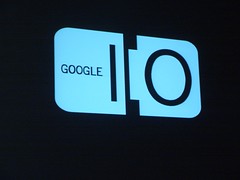 Last week I had the pleasure of attending the Google I/O, a two day developer gathering in San Francisco. The first session I sat in on was OpenSocial: A Standard for the Social Web with Patrick Chanezon, Kevin Marks, and Chris Schalk from Google. The session aimed to answer "what does social mean?" and "how do we socialize objects online without having to create yet another social network?".While APIs provide data for friends, profiles, and activities in social networks, different APIs make it difficult for developers. This is where OpenSocial comes in. Based on HTML+Javascript+REST+OAuth, OpenSocial was promoted in the session as an easier way to develop applications for a variety of participating social networks at once. With upwards of 275 million user distribution, OpenSocial can definitely be seen as an API that opens the flood gates.While OpenSocial is great for developers, what do users get out of it? Chanezon, Marks, and Schalk explained that the users are able to then use more applications. More applications aren't necessarily a good thing, however, like in the case of Facebook where many users are experiencing the fatigue of using applications that lack relevance.Marks discussed how containers (e.g. social networks) don't choose users - they simply grow through homophily and affinity, sometimes bringing unexpected user bases. Because of this, OpenSocial provides a sense that specialization is no longer required. Though the lack of specializing may benefit the developers, I think it may hurt the users in the long-run. A lack of application specialization based on each individual network often overlooks the intricacies and quirks that resonate with the individual userbase, thus creating a less-than-ideal user experience and a lack of unique value propositions. OpenSocial may represent progress for open standards, but not if it means an outbreak of "Zombies vs. Vampires" starts following you from network to network.
Last week I had the pleasure of attending the Google I/O, a two day developer gathering in San Francisco. The first session I sat in on was OpenSocial: A Standard for the Social Web with Patrick Chanezon, Kevin Marks, and Chris Schalk from Google. The session aimed to answer "what does social mean?" and "how do we socialize objects online without having to create yet another social network?".While APIs provide data for friends, profiles, and activities in social networks, different APIs make it difficult for developers. This is where OpenSocial comes in. Based on HTML+Javascript+REST+OAuth, OpenSocial was promoted in the session as an easier way to develop applications for a variety of participating social networks at once. With upwards of 275 million user distribution, OpenSocial can definitely be seen as an API that opens the flood gates.While OpenSocial is great for developers, what do users get out of it? Chanezon, Marks, and Schalk explained that the users are able to then use more applications. More applications aren't necessarily a good thing, however, like in the case of Facebook where many users are experiencing the fatigue of using applications that lack relevance.Marks discussed how containers (e.g. social networks) don't choose users - they simply grow through homophily and affinity, sometimes bringing unexpected user bases. Because of this, OpenSocial provides a sense that specialization is no longer required. Though the lack of specializing may benefit the developers, I think it may hurt the users in the long-run. A lack of application specialization based on each individual network often overlooks the intricacies and quirks that resonate with the individual userbase, thus creating a less-than-ideal user experience and a lack of unique value propositions. OpenSocial may represent progress for open standards, but not if it means an outbreak of "Zombies vs. Vampires" starts following you from network to network.